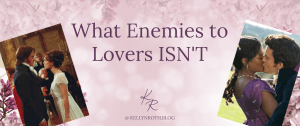
I had some bad news a while ago, and I need to write something like this to keep my mind off of it, so here’s this. Enjoy.
Okay, let’s do a better introduction. Today I wanted to talk about something I haven’t really been able to discuss in a while because I haven’t had any great ideas. Inspired by Grace Johnson’s recent guest post on my blog (and all her related talk about enemies to lovers), I decided to tackle the subject of the romance “genre,” such as it is. (Read that guest post to see why I put the word “genre” in quotes!)
And specifically, I want to talk about one of the most famous and infamous romance tropes—enemies to lovers!
Boy meets girl … and falls in hate
 Enemies to lovers was founded by the great Jane Austen in her novel, Pride & Prejudice. Now, I don’t know for sure if that was the first novel you could officially call an “enemies to lovers” by definition of the trope (technically, Taming of the Shrew, I guess? Though that falls more into the 1930s/40s comedy trope that I mention below), but it was certainly the first story in literary format that has stuck with us long enough to be considered the beginning of said trope.
Enemies to lovers was founded by the great Jane Austen in her novel, Pride & Prejudice. Now, I don’t know for sure if that was the first novel you could officially call an “enemies to lovers” by definition of the trope (technically, Taming of the Shrew, I guess? Though that falls more into the 1930s/40s comedy trope that I mention below), but it was certainly the first story in literary format that has stuck with us long enough to be considered the beginning of said trope.
This is the true example of how to do this trope correctly, and if you’re not familiar with it, you should avoid this trope.
No … seriously. She does it SO well.
What is Enemies to Lovers?
According to this website:
Enemies to lovers trope is when two characters start off as enemies and, over the course of a book or series, end up in a romantic relationship. These ‘enemies’ have to overcome their differences or misconceptions about each other, and in the process, they fall in love.
A few examples of “enemies to lovers” include:
The most recent season of the (mature, erotic, you-should-avoid-watching-it) show Bridgerton (though this season wasn’t really smutty except for like one scene but that’s a conversation for another day).
You’ve Got Mail (and the earlier The Shop Around the Corner).

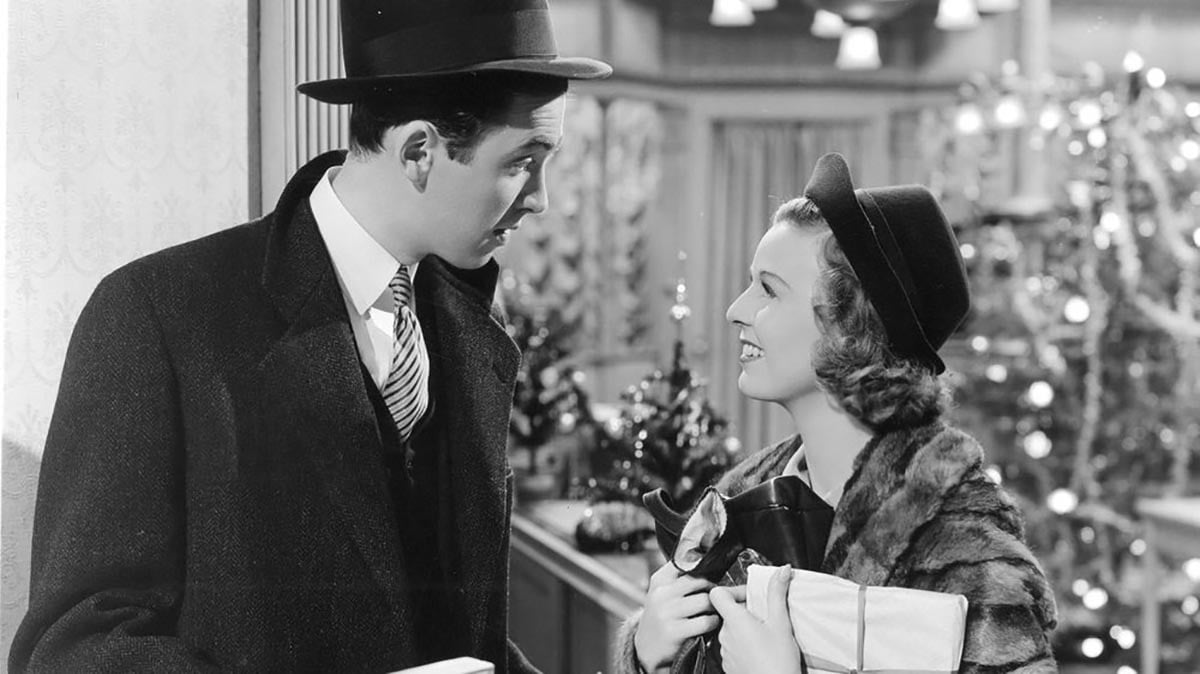
Mary and Matthew in BBC drama show Downton Abbey.

Leslie and Ben in the comedy TV show Parks & Rec.
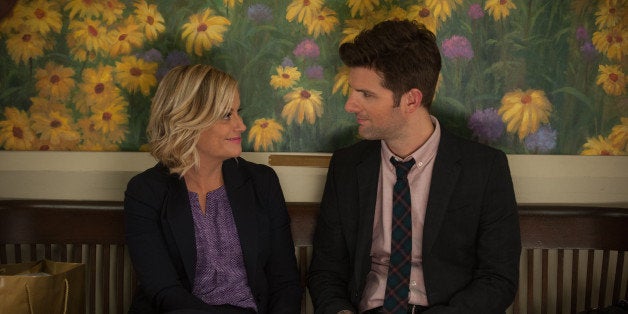
And … a lot of other novels, movies, and TV shows that I can’t seem to remember. It’s used a lot. Sometimes it comes across better than others.
Further, this trope was used in a lot of 1930s-1950s screwball comedy romances, one way or another. For instance, His Girl Friday, High Society (or Philadelphia Story, the movie the musical was based on), even Bringing Up Baby to a degree, and … gosh, so many. It’s a whole THING.
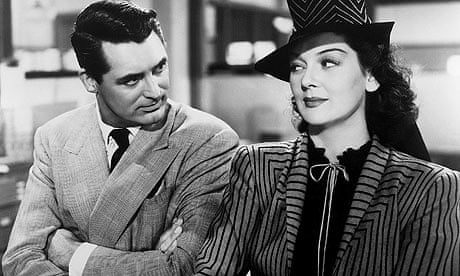


(And I hesitate to even include these ones, because a lot of them are more “one-sided love.” In High Girl Friday, Cary Grant’s character wants Rosalind Russell’s character to come back to him even as he teases her. Same with High Society & Bing Crosby’s character, still in love with his ex-wife, played by Grace Kelly – and Philadelphia Story, which again features Cary Grant in a similar role opposite Katharine Hepburn. In Bringing Up Baby, though Cary Grant’s character HATES Katharine Hepburn’s character (kinda), she has a bit of a crush on him. And that’s probably the more common trope of these types of movies. But I still feel a lot of the hate-to-love stuff comes through in these movies. I learned a lot about writing that kind of dialogue from Rosalind Russell and Grace Kelly and Cary Grant!)
There’s been so many renditions of this trope that it sometimes feels old … or just annoying. I mean, come on, guys! Besides, it’s grown more popular among YA audiences lately, meaning … well, it’s kind of become immature.
“The enemies-to-lovers trope encapsulates the entertainment value of drama and messy relationships. Readers love the enemies-to-lovers trope in YA fiction because its entertainment and messages are appealing. From the ridiculous arguments to the passionate hatred, the enemies-to-lovers fiction trope thrives on messiness.”
As I’ve talked about on my Instagram lately, I am also attracted to the messiness … but goodness, sometimes it’s too much.
You know why?
Because it has to be done right.
How Enemies to Lovers Works
I argue that there’s a certain reason enemies to lovers sometimes falls flat in fiction—and sometimes doesn’t. And it all has to do with the CONFLICT.
Namely, if the hatred comes from personality traits that the character quickly correct, it … doesn’t work.
I mean, hating someone for their personality alone is a human thing, but when it comes down to it, it’s also something that both forbids romance and shows a lack of maturity in the hater.
Enemies to lovers, more than any other trope in romance, thrives on that tension—that “I want you but I can’t” element that hits a certain part of our heart that we can’t. In some ways, it’s replaced the “our families/circumstances won’t let us” (Romeo & Juliet, etc.) as we move from a society valuing the physical into one valuing the mental.
It always starts with literature/other art forms, right? And it’s no surprise that the first rise of such plot lines came in the early 1800s and rose in popularity to be a common theme in 1930s/40s movies (meh, but we’re going with this line of thinking, so no reality #MyWayortheHighway).
It’s further no surprise that it’s grown to be more popular in YA romance and inspirational-ish, Hallmark-ish romance, which are arguably the two least mature subgenres of romance on the market at the moment.

(Who am I kidding? This movie was JUST before that YA/Hallmark trend, and it is amazing, and I love it, and I recommend it to everyone because it is SO GOOD. ALSO, this is the best roll I have ever seen this guy in and you know I hate him. Matthew Goode is so good in this movie, Amy Adams is charming and awesome, and it’s just … it’s another great example of this trope. I’ll stop now, but I love Leap Year. #IRELAND)
But I digress.
Because you know, folks, it DOES appeal to the immaturity of us. The desire to just spite someone who we have a bad opinion of—to allow our “pride and prejudice” to overcome even our extreme attraction and longing for some other person.
Yes, we will be be coming back to Pride & Prejudice a lot in this article, but you probably knew that coming in.
THAT HAND TOUCH, y’all. That’s what enemies to lovers is. It’s that FEELING that they NEED to be together but are just too STUBBORN and we HATE them and just GAH.
However, despite the innate immaturity (and we are all immature, so I mean that in the most positive way—EMBRACE THE IMMATURITY OF HUMANITY IN YOUR WRITING!), this trope is far from dead. It has classic roots. It’s not leaving.
So what then? Well, let’s break the trope down to help us understand it a little better.
The Roots of Enemies to Lovers
Enemies to lovers tends to follow a fairly simple structure that is imitated by most romances.
To quote Romancing the Beat:
“Whatever is keeping your characters from falling in love … is what your book is about.”
So in an enemies to lovers romance, the HATRED is at the center of your story. Keep that in mind as I go over these “story beats,” semi-inspired by Romancing the Beat and mostly inspired by “me defining things however I want.”
Act 1:
Opening/Beginning:
The main characters are introduced. This is generally a short-ish section, and in most romances, we get a point of view scene from both characters to establish their “normal world.”
Inciting Incident:
In most romances, this is the “meet cute.” That’s another way of saying, “I shoved these two human beings in a room. Now what?”
This can either be their first meeting or it can be a point where their hatred grows stronger in an enemies-to-lovers romance.
Reaction to Inciting Incident:
How do they feel about each other?
Eh, they probably … they probably don’t like each other? Hate’s the game.
First Plot Point:
They hate each other, but they are a part of the same world. They can’t get rid of each other. There’s a lot of ways this can happen – they can be stuck in the same room, the same crowd, or better yet, the same project/goal/job.
Act 2:
Obstacles
They’re still saying “no way!” as Romancing the Beat puts it.
However, not long after that, they get an idea this could work. Generally, characters will be influenced by either an outside force or something new they glimpse in each other during these obstacles to be drawn toward each other.
In less civilized novels, this generally includes some hardcore “I just wanna have sex with this person” but that’s too course for us, now, isn’t it? Our characters would like to have a normal relationship with each other – and that includes attraction eventually leading to desire – but that shouldn’t be their main motivation, as in real life.
Pinch Point #1:
BUT NO. IT’S NOT WORKING.
The pinch point is a reminder of the antagonist’s forces, and in a romance, that’s, “Oh, my gosh, here’s this thing that means we can’t be together!” Whether that pleases your characters or not is up to you …
More Obstacles
Maybe. Just … maybe.
Their desire is deepening. The tension is there. The chemistry is overwhelming. Will they/won’t they? But even while this happens, of course the main plot (whatever that may be, because remember, you do need to have a plot!) is heightening, too.
Midpoint:
This can happen in one of two ways.
Either they want each other to the point where their temptation causes them to do something dumb (see below, usually, or something related like one of those “kisses that changes everything” scenes) or they find out something new about each other.
In a lot of smutty novels/movies, this is where the characters become unnecessarily intimate. 😉 But in our books, we can avoid that, right? At least, unless it’s an arranged marriage/marriage of convenience romance, in which case I will forgive you for making an allusion or two. Because reality is a thing. #DearChristians #BelieveItorNot #YouAreaProductof #SomeSortofSmut*
(*Not that sexual encounters in their proper place are smut, but the line between what I’d define as lust and what I’d define as longing can be a thin gray blur, so for now, I’ll be facetious and offend enough people to get them to click off just because #ICan #SoWhyNot) (p.s. when I was an immature child, I used to say one of my slogans was, “Why not?” and what I really meant by that is, “Why not cause a little chaos today?” And I sometimes wake up and choose Insanity. So there ya go.)
Midpoints are challenging and are literally the centerpiece of the story, so consider reading some alternative materials on this (like those on Helping Writers Become Authors) to learn more!
Obstacles:
Yet we run back into the obstacles again! There’s so much going on, and the characters are tossed about as per normal.
Pinch Point #2:
Another reminder of the antagonistic force and why they can’t be together. This can also come right after the midpoint!
(Physical) Disaster:
This should NOT be “oh, no! We can’t be together!” Usually it’s something that changes the protagonist’s life, crumbles their goals, or makes something BAD happen, basically. More on this later, if I think of it.
Act 3:
(Mental) Disaster:
All is lost. This reaction to the physical disaster, which I’ll reflect on more later, really shakes the characters’ world.
Realization:
This can also come after the grand gesture, but I feel like it’s more powerful if the character comes to a separate realization about their own struggles entirely separate from their love interest. After all, let us never say that romance “completes” us. Only God can do that. (Remind me later to do a whole blog post on Bridgerton and why it’s not the smut that makes it a bad piece of filmography, despite the fact that the smut is overwhelming, especially for a longing-for-purity-in-culture audience like moi, in the first season. Spoiler alert: it’s the whole “you complete me” thing.)
Grand Gesture & Happily Ever After:
What it sounds like! Something is done that is romantic, and they get together. They’re together, and ideally, they have children. 😉
Where Pride & Prejudice EXCEEDS
Because just “succeeds” isn’t enough.
Note: I decided to use the not-entirely-accurate-to-the-book’s-plot-but-accurate-to-the-book’s-vibes 2005 adaptation of Pride & Prejudice, but the book roughly follows this structure, too. Also, this means that watching Pride & Prejudice and setting timers to determine when plot points are. So yeah.
Act 1:
Opening/Beginning:
We introduce the main character, Elizabeth, and through her family’s discussions and a lot of awesome shots, how she thinks and how her family thinks and just … everything is brilliantly set up here, from the societal norms to the main goal of Mrs. Bennet to Mr. Bennet’s eccentricities to the individual personalities of Lizzy’s siblings.
(Also, every time you spell it Lizzie, a single gentleman in possession of a large fortune dies, so keep that in mind.)
Inciting Incident:
Technically the inciting incident here is really the fact that Mr. Bingley and his entourage are here. However, if you want to set up an official inciting incident for the romance subplot, that’s the moment that Lizzy says, “I would not dance with him for all of Derbyshire, let alone the miserable half.”
Reaction to Inciting Incident:
Obviously we all know that Lizzy IMMEDIATELY starts just harassing Darcy. Even though he looks like a dying puppy. But to be fair, he totally deserves it.
First Plot Point:
This surprised me during my research, but the first plot point is technically Wickham telling Lizzy about his version of Mr. Darcy’s involvement in his life. This thrusts Lizzy firmly into the second act which she (mostly) spends hating Darcy.
The other thing to keep in mind is that everything before this is SETUP. Jane Austen (and Joe Wright) is just SETTING THINGS UP, yet so many things happen. So seeing act 1 as introduction gives you a rather offish impression.
Act 2:
Obstacles
Lizzy is embarrassed by her family at the Bingley’s ball, is disappointed that Wickham is not present, and of course encounters the obstacle of having that lovely hate-dance with Darcy. Which is just glorious.
Pinch Point #1:
This is her family being embarrassing at the ball, causing Lizzy to actually comment on it! Which I think is a big deal for her. It also endangers Jane’s relationship with Bingley.
More Obstacles
Amongst Lizzy’s obstacles during this section are Mr. Collins proposing and then being rejected, and the Bingleys’ and Mr. Darcy leaving Netherfield.
Note how, without officially challenging Lizzy’s perspectives, there are some things about this that shake Lizzy’s pride and prejudice, of which I am convinced she has in equal balance. She must rethink her relationship with her friend Charlotte, for instance, and watch her beloved sister be rejected, and wonder if her impressions of Mr. Bingley were incorrect all along.
Also, Lizzy spends way too much time on a swing. This I freely admit.
She then travels to visit Charlotte where even more can happen to mess with Lizzy and introduce her to a broader world that the one she’s created in her own mind. This includes meeting Lady Catherine and her daughter, discovering that Mr. Darcy is there, and probably thanking her lucky stars that she’s not married to Mr. Collins.
Midpoint:
The weird thing about this movie is that the proposal scene is usually right in the middle, but in this one, it’s actually a little late, unless I’m incorrect. I can’t find the exact minute mark because the credits mess with the total runtime and I may have accidentally messed up my timer, but I think it occurred around 67 minutes when it should’ve been at 63 minutes, give or take.
But around 63 minutes, Lizzy is just playing the piano and then it transitions into her writing a letter to Jane and then of course we get Mr. Darcy awkwardly showing up at Charlotte’s house for like 20 seconds before he FLEES. Which doesn’t feel midpoint-worthy, at least to me. However, since it does lead directly into the midpoint, I guess it works.
But no, the real midpoint here NEEDS to be Elizabeth finding out from Col. Fitzwilliam that Mr. Darcy separated Jane and Bingley and then presumably bragged about it – and then the rain proposal, which I consider to be the primary midpoint that shakes the protagonist’s world! The letter that follows directly afterwards changes, well, everything.
Obstacles:
After this, Elizabeth is a little unsure how to proceed. The midpoint is supposed to make you reflect, and she does indeed reflect (even before receiving said letter). The other thing is that Lizzy then stands up to her father and realizes he doesn’t really care about his daughters a whole lot, and she comes to have a more realistic view of him, her mother, and her siblings. #FindingtheThematicTruth
I’m also reminded of how much I love Lizzy’s aunt and uncle. Her going with them on that lil’ vacay is so much fun and of course gives us some of the most beautiful shots in the movie.
Pinch Point #2:
At around 84 minutes (1 hr 24 m), we should have our second pinch point. On one of my timers, which is the one I’m closest to trusting but which is probably not accurate still, Lizzy’s arrival at Pemberly & subsequent “oops” happened at 1:20, which I think is pretty close. (At precisely the above minute mark, Lizzy sees Darcy with Georgiana and then is caught staring at them like a weirdo, and really, this also works.)
Also, I find it hilarious that they devoted FOUR minutes to exploring Pemberly. But I can’t blame them because it is beautiful.
Basically, this serves to give our protagonist another good shake, often prodded on by the midpoint. Both of those fit the bill pretty closely!
(Physical) Disaster:
At 1:29, Elizabeth finds out that Lydia has eloped with Mr. Wickham, which is six minutes early, but oh well. I guess we needed more time for the Mrs. Darcy scene. For which I thank Joe Wright profusely.
Here is one place where I feel like Jane Austen rises above other enemies to lovers romances. At this point, Lizzy doesn’t HATE Mr. Darcy. She’s actually starting to come around to him. If Lydia hadn’t eloped, she might have given him another chance just based on what all he learned.
Usually the physical disaster in an enemies-to-lovers romance will include a conflict directly between the protagonists rather than in the story at whole. And this sometimes works. Sometimes.
But I personally feel that this cheapens the experiences of the midpoint and beyond. And I personally hate the romance trope where the main characters fall out at the 75% mark. So I prefer this kind of exterior conflict greatly. Besides, it also takes us out of the realm of emotions.
The 75% mark in a romance should remind us that there is indeed a world bigger than our main characters, and big things are happening. For my sanity, romance writers, if nothing else! Especially since in the next point …
Act 3:
(Mental) Disaster:
In the mental disaster, sometimes called the dark point, the character has to THINK about how STUPID they were and FIX THEMSELVES.
Elizabeth realizes she has neglected her family by not telling them about Wickham and that Mr. Darcy is probably a good egg but because of that family neglect, she’s lost her chance with him when she could’ve snapped him up even though he was kinda right and her family does suck.
Though we don’t get to see it, Mr. Darcy also probably has that same realization (similar, anyways, with realizing he should’ve taken Wickham out). And then, as we know, he reacts. But we don’t find that out until later …
Realization:
The realization technically comes after the grand gesture in this story, which works really well. However, Lizzy is already pretty convinced that Darcy is a peach before this because of Darcy’s letter, etc.
This also ties into some of the “mental disaster” scenes where Lizzy stands there wanting to die while her mother cries then sees how helpless her father is then sees how her mother’s demeanor changes after Lydia’s marriage. And just … everything about this brilliantly shows Lizzy what a fool she’s been and what the real truth is.
Grand Gesture:
Darcy’s grand gesture here happens off screen, but honestly, it’s just as effective to learn secondhand of his saving of Lydia. (Though I also hope Lydia is miserable forever, because I hate her. But that’s beside the point.)
Happily-Ever-After:
They get married! And Lizzy is Mrs. Darcy! *swoons*
I’ll also add the K.M. Weiland’s writing advice blog/website, Helping Writers Become Authors, has a great story structure breakdown here of the novels.
Other than fitting seamlessly into the structure, Pride & Prejudice actually bucks a lot of the traditional tropes of enemies to lovers and romance in general, which makes no sense because, again, this book is foundational to the genre! (How did Austen do it?!)
One thing in particular to note: Bridgerton Season 2 (that smutty romance series on Netflix) contains a lot of tropes and also some misunderstandings of tropes and ALSO a lack of structure that has made the second season a bit underwhelming.
That’s my most recent example of how things could be done wrong. Because much as I came to love Anthony and Kate, the series fell into one of the most common problems and barely gave us any time with them as a couple. In general, they either hated each other or insisted (for reasons they didn’t explain well, probably because of cuts/rewrites due to the whole Covid-19 filming stuff) that they couldn’t be together. Which was frustrating. And not in a good way.
Sometimes it’s good for a romance novel or movie or TV show to be frustrating. However, a lot of enemies to lovers romances have a tendency to take it too far.
But they also try to cram a lot of physical attraction and longing into it (in Bridgerton‘s case, lusting, no matter how they try to define it as “love”) that doesn’t make sense.
A generous dash of physical attraction between every romantic pair makes perfect sense and is in fact necessary. However, there’s a point at which it stops being enemies-to-lovers and starts being Romeo & Juliet but stupid and, as mentioned before, only determined by personal structures that are usually ill-explained and make us thoroughly dislike the main characters. Which seems to happen a lot quicker than most writers think.
Anyways, now that I’ve talked about all that, let’s get into some fixes.
Ways to Fix the Enemies to Lovers Trope
(Note: you can combine these features to take them one at a time. I believe any of these five will sharpen your enemies to lovers romance!)
1: Make it “rivals to lovers.”
This is so cute and builds in the stakes. Maybe your two main characters are rival bakers at a contest or they both want their younger sister to marry the same guy or … well, there’s a lot of options here. This also takes the conflict off of simply personal stakes, especially if there are driving motivations behind their individual goals.
2: Make sure the reason they hate each other MAKES SENSE.
Don’t just make it a personality thing. Please. That’s so annoying. And if it has to be a personality thing, resolve it quickly and let your trope fade. The conflict has to make sense and not make us hate the characters.
Because “enemies to lovers” should not be between our female lead and the reader, no matter what romance writers try to tell you. They should have faults, yes, but we should understand their motivations and root for them even so.
3: Don’t make it an all-the-sudden give in … but don’t let it drag on, either!
Let them struggle. Make them HURT. Let them be TORN. And when they do give in, make it make sense. However, you also don’t want to drag it on so long that everyone is caught in six seasons of absolute idiocy that has no real reason besides to drag the story on.
Sometimes it’s not going to make sense for two characters to be enemies throughout the entire story – and that’s okay. Relationships can grow and evolve faster than you planned. And clinging to a format just because isn’t the way to go at all.
4: Make sure they feel awful.
Do you remember how guilty Elizabeth was after she realized Darcy wasn’t a jerk – just a socially awkward child? That’s what we need! It’s important for characters to feel guilty after they act like idiots and make proper amends. (That’s part of what the “grand gesture” is, but even if that doesn’t happen in precisely the same format or doesn’t have anything to do with the main conflict of the story, it still can mend fences between your characters.)
5: Remember this trope has its roots in satire.
And tropes always become most annoying when they ignore the fact that they were rooted in satire (see Romeo & Juliet, Hamlet, and other plays Shakespeare used to make fun of people like the chaos hobo he was). So, therefore, have fun with it!
My biggest problem with a lot of enemies to lovers romances is that they just feel ridiculous and childish. The main characters usually blow things out of proportion and act ridiculous.
However, so do people in real life! So remember that the purpose of this trope was originally to poke fun at the rigid seriousness, the prides and the prejudices, that so many of us hold on to when we ought not to.
And with that thought, I’ll leave you.
TTFN!
~Kell~
p.s.
What do you think of the genre? And what would you like to read about next?


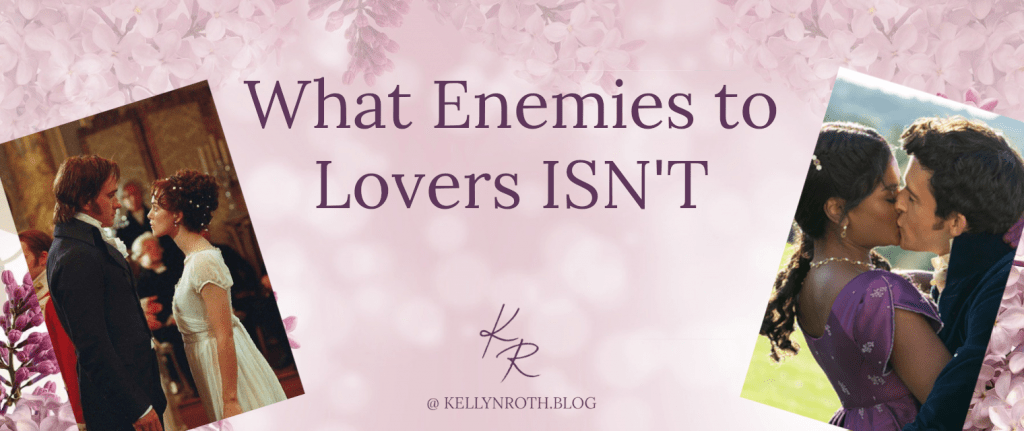

9 Responses
This.
Was.
Perfect.
Thank you.
Thank you, Grace! 😀
You’re so welcome! <3
LOLLLLLLL! I need this for The Woodsman even though Nicki & Jonathan aren’t really enemies-to-lovers, though they do have an elephant to talk about…
Also, these tags are hilarious: #DearChristians #BelieveItorNot #YouAreaProductof #SomeSortofSmut*
It’s so true though…
Glad to hear it! And thank you. 😛
I LOVE THIS POST!!! Enemies-to-lovers is one of my favorite tropes when it’s done well, lol!
Thank you, Saraina! Yes, I agree! It can be so much fun when it’s executed in a way that make sense! I honestly need to read more great enemies-to-lovers stories …